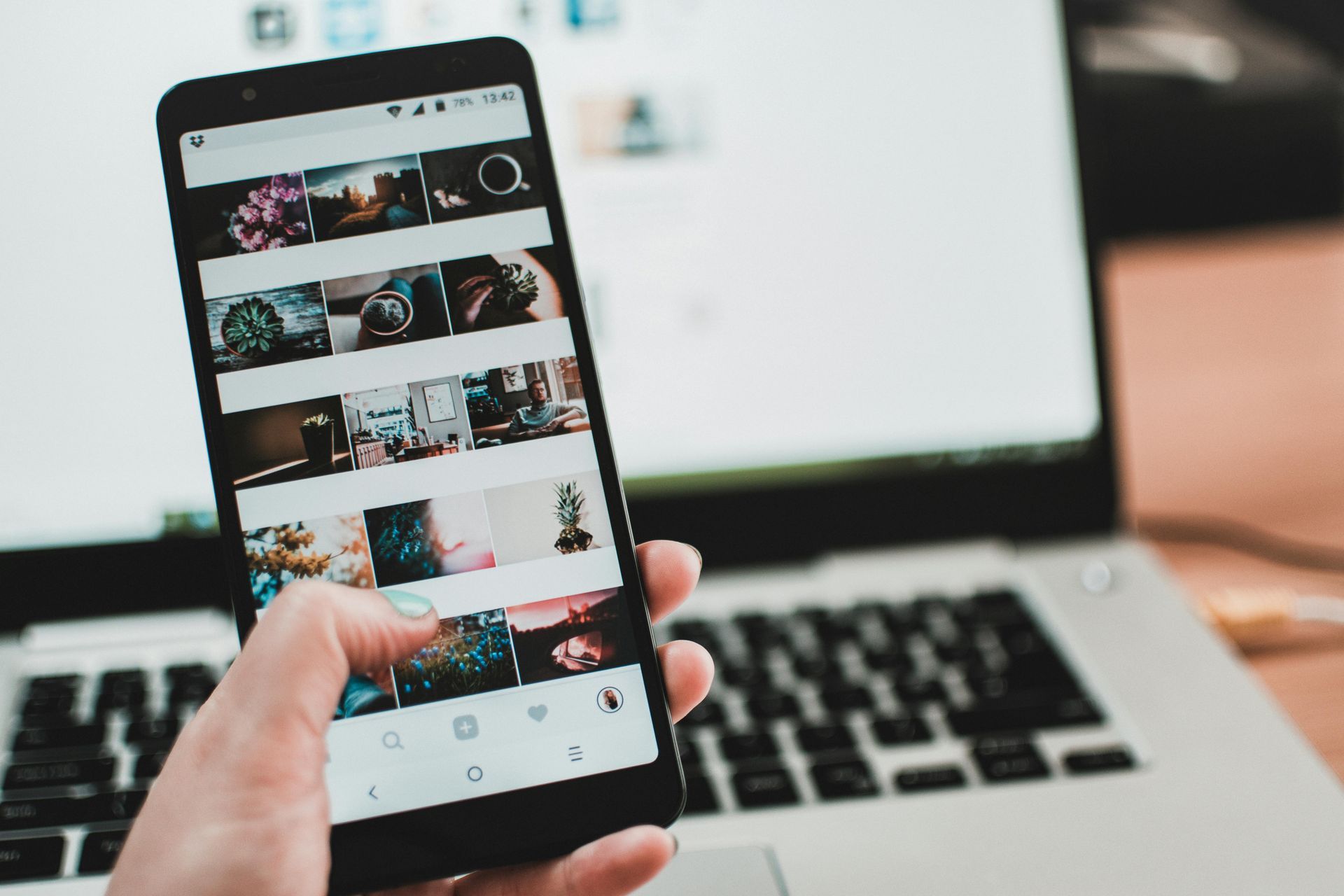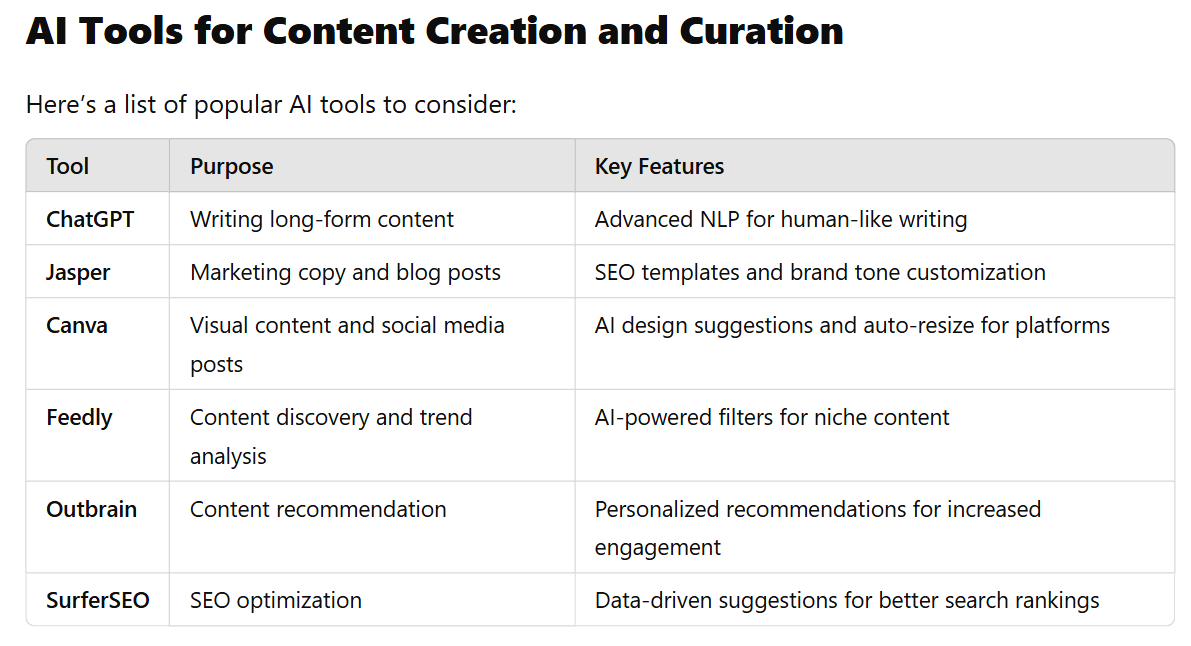Leveraging AI for Content Creation and Curation

Table of Contents
1. Introduction: Why AI in Content Creation and Curation?
2. AI in Content Creation
- Generating Blog Posts and Articles
- Crafting Social Media Posts
- Video and Audio Content Creation
- SEO Optimization
3. AI in Content Curation
- Automating Content Discovery
- Personalizing Content for Different Audiences
- Enhancing Visual Content Curation
- Streamlining Email Newsletters
4. AI Tools for Content Creation and Curation
5. Best Practices for Leveraging AI
- Combine AI with Human Creativity
- Focus on Quality Over Quantity
- Use Data to Drive Decisions
- Stay Ethical
6. The Future of AI in Content
7. Conclusion
8. Call to Action
Artificial Intelligence (AI) has revolutionized the digital landscape, significantly impacting how businesses approach content creation and curation. From generating high-quality blog posts to selecting the most engaging articles to share with an audience, AI has become a vital tool for marketers, businesses, and content creators. This article explores how to leverage AI effectively in content creation and curation, focusing on tools, strategies, and best practices.
Why AI in Content Creation and Curation?
AI offers several advantages in the realm of content creation and curation:
- Efficiency: AI tools can create and curate content faster than humans, saving time and resources.
- Scalability: AI enables businesses to produce or curate large volumes of content without compromising quality.
- Personalization: AI algorithms analyze user behavior and preferences to tailor content that resonates with specific audience segments.
- Cost-Effectiveness: Reducing the reliance on manual labor for content tasks can lower costs significantly.
- Innovation: AI tools often introduce fresh, creative ideas by analyzing trends and patterns that humans may overlook.

AI in Content Creation
1. Generating Blog Posts and Articles
AI-powered platforms like ChatGPT and Jasper can craft blog posts, articles, and other written content efficiently. These tools use Natural Language Processing (NLP) to mimic human writing and create engaging, SEO-optimized content.
- How to Use: Provide the AI tool with a detailed brief, including the topic, tone, target audience, and keywords.
- Best Practices: Always edit and fact-check AI-generated content to ensure accuracy and relevance.
2. Crafting Social Media Posts
AI tools like Canva's Magic Write or Copy.ai specialize in creating captivating social media captions, hashtags, and even full campaigns.
- Benefits: These tools help maintain consistency in brand voice and optimize posts for maximum engagement.
- Pro Tip: Pair AI-generated captions with visually appealing graphics or videos to boost impact.
3. Video and Audio Content Creation
AI isn't limited to text—it also excels in video and audio content creation. Tools like Synthesia generate AI avatars and voiceovers, while Descript helps with audio editing and transcription.
- Application: Use AI to create explainer videos, podcasts, and tutorials.
- Advantage: These tools make high-quality multimedia production accessible to small businesses and solo creators.
4. SEO Optimization
AI tools like SurferSEO and Clearscope enhance content by analyzing keywords, search intent, and competitor strategies. They help optimize your content for search engines, improving visibility and traffic.
- Tip: Use AI recommendations to structure content, insert keywords naturally, and craft meta descriptions.
AI in Content Curation
Content curation involves selecting and sharing the most relevant and valuable content for your audience. AI streamlines this process by analyzing vast amounts of data and identifying high-performing content.
1. Automating Content Discovery
Tools like Feedly, Pocket, and Curata leverage AI to discover trending content across industries. They analyze metrics like engagement rates and social shares to surface the most relevant pieces.
- How to Use: Set up filters based on keywords, topics, or domains to receive curated content tailored to your niche.
- Pro Tip: Combine curated content with original insights to add value for your audience.
2. Personalizing Content for Different Audiences
AI platforms like Outbrain and Taboola use algorithms to recommend content based on user behavior and preferences. This personalization boosts click-through rates and audience satisfaction.
- Example: A fitness brand can use AI to curate articles on workout routines for beginners, meal prep for athletes, and wellness tips for seniors.
3. Enhancing Visual Content Curation
AI tools like Pinterest Lens and Canva’s AI features curate visually appealing content. These tools analyze colors, patterns, and styles to recommend visuals that align with your brand identity.
- Pro Tip: Use AI-curated visuals to complement your written content, ensuring cohesive storytelling.
4. Streamlining Email Newsletters
AI-powered tools like Mailchimp's Smart Recommendations or HubSpot’s AI features optimize email content by curating the most engaging articles and subject lines.
- Benefit: This keeps subscribers engaged and increases click-through rates without manual effort.


Best Practices for Leveraging AI
1. Combine AI with Human Creativity
AI is a tool, not a replacement for human creativity. Use AI to handle repetitive tasks, while focusing your creative energy on strategy and storytelling.
- Example: Use AI to generate a draft, but refine it with your unique perspective and voice.
2. Focus on Quality Over Quantity
AI allows for high-volume content production, but prioritize quality to maintain audience trust.
- Tip: Invest time in editing and enhancing AI-generated content for maximum impact.
3. Use Data to Drive Decisions
Leverage AI analytics to understand what content resonates most with your audience. Tools like Google Analytics and AI-based heatmaps provide actionable insights.
4. Stay Ethical
Transparency is key when using AI. If your content involves sensitive topics, ensure that AI-generated material is accurate and reviewed by experts.
- Pro Tip: Disclose when content is AI-generated to build trust with your audience.
The Future of AI in Content
As AI evolves, it will continue to reshape content strategies. Advancements in machine learning, predictive analytics, and natural language understanding will make AI even more intuitive and effective.
- Trends to Watch: AI-powered voice search optimization, hyper-personalized content, and real-time audience interaction tools.
Conclusion
Leveraging AI for content creation and curation offers immense potential for businesses and creators. From automating routine tasks to providing valuable insights, AI enhances efficiency, creativity, and audience engagement. By integrating the right AI tools and strategies, you can stay ahead in the ever-evolving digital landscape.
Embrace the power of AI today and transform your content strategy into a competitive advantage!
Ready to revolutionize your content strategy? Explore AI-powered tools and take your content creation and curation to the next level!
Welcome To Our Blog





